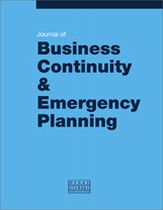Tactical security controls for unpredictable events: Aligning security tactics with business continuity for resilience in the face of the unknown
Abstract
Unpredictable threats, ranging from civil unrest and cyber-physical disruptions to infrastructure failures, continue to challenge security and business continuity professionals. Traditional risk management approaches often fail in these fast-evolving scenarios, necessitating a shift toward tactical security controls that are adaptable, scalable and integrated within business continuity frameworks. This paper explores the security effects model, a strategic approach that categorises security controls based on the outcomes they achieve rather than the specific threats they address. By leveraging seven key security effects — deterrence, access control, detection, assessment, delay, response, and recording and communication — organisations can design security postures that remain effective even in highly dynamic environments. Among the abovementioned seven, the paper identifies four mission-critical security effects for unpredictable threats: detection, assessment, delay and response. By aligning security controls with these mission-critical effects, organisations can enhance early warning capabilities, streamline crisis assessment, buy critical response time and ensure cohesive multiteam coordination. Using a structured ‘what if?’ methodology, the paper demonstrates how organisations can proactively identify vulnerabilities and prepare security measures that are functional across multiple threat vectors. A case example using the Francis Scott Key Bridge collapse illustrates how applying this approach can improve security resilience against both accidental and intentional disruptions. The paper provides practical, actionable guidance for security and business continuity professionals, emphasising the need for an integrated security-continuity framework that aligns with industry best practices, including ISO 22301 and American Society for Industrial Security (ASIS) enterprise security risk management (ESRM). By shifting away from reactive security models to proactive, effects-based tactical controls, organisations can build resilience against the unknown while ensuring operational continuity in the face of emerging threats. This article is also included in The Business & Management Collection which can be accessed at https://hstalks.com/business/.
The full article is available to subscribers to the journal.
Author's Biography
Rachelle Loyear Vice President of Integrated Security Solutions at Allied Universal, leads the organisation’s Enterprise Security Risk Management programme. Throughout her career, Rachelle has dedicated herself to developing and managing programmes within corporate security organisations. Her expertise lies in security risk management with a focus on enterprise resilience against various physical and cyber risks. Rachelle’s contributions extend beyond her professional roles. In 2016, she co-authored ‘The Manager’s Guide to Enterprise Security Risk Management: Essentials of Risk-Based Security’, followed by the release of ‘The Manager’s Guide to Simple, Strategic, Service-Oriented Business Continuity’. She is also a co-author of the 2018 book, ‘Enterprise Security Risk Management: Concepts and Applications’. Active in the industry, Rachelle serves on the American Society for Industrial Security (ASIS) North American Board of Directors and previously chaired the Enterprise Security Risk Management (ESRM) Community Steering Committee. She also contributes to the Cybersecurity Advisory Board for Security Industry Association (SIA). Rachelle holds certifications as a Certified Information Security Manager (CISM) through Information Systems Audit and Control Association (ISACA), a Master Business Continuity Professional (MBCP) through DRI International and a certified Project Management Professional (PMP) through the Project Management Institute (PMI). Her multifaceted expertise and leadership make her a valuable asset in shaping security and risk management practices. Rachelle earned her MBA in business from the University of Phoenix in 2007 and her BA in history from the University of North Carolina at Charlotte in 1998. Her academic background, coupled with her extensive professional experience, positions her as a thought leader and influencer in the field of security risk management.
Mg William J. Walker US Army (Ret). is Chief Security Officer (CSO) at Allied Universal, bringing over 30 years’ distinguished service in security, law enforcement and military leadership to his role. William was a Special Agent of the Drug Enforcement Administration (DEA) and served as the 38th Sergeant at Arms, US House of Representatives, 117th Congress. As a former DEA Criminal Investigator and Deputy Assistant Administrator, William’s expertise spans national and international investigative operations, intelligence analysis and regulatory compliance. With promotions to the Senior Executive Service and appointment as a Senior National Intelligence Service Officer by the Director of National Intelligence, he has held positions of increasing responsibility and significance. William earned Master’s degrees from Chicago State University, National Intelligence University and American University and his Bachelor’s degree from the University of Illinois. He completed the Executive Leaders Program at the Center for Homeland Defense and Security, and national security programmes at George Washington, Harvard and Syracuse universities. Williams is a Massachusetts Institute of Technology (MIT) International Relations Fellow, a National Academy of Public Administration Fellow and life member of the Council on Foreign Relations. He is also a life member of the Fraternal Order of Police and the International Association of Chiefs of Police, reflecting his commitment to excellence in security and public service.
Citation
Loyear, Rachelle and Walker, Mg William J. (2025, November 4). Tactical security controls for unpredictable events: Aligning security tactics with business continuity for resilience in the face of the unknown. In the Journal of Business Continuity & Emergency Planning, Volume 19, Issue 2. https://doi.org/10.69554/RDBQ6306.Publications LLP
